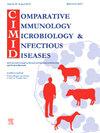阿尔及利亚产蛋综合征病毒76在蛋鸡群中血清流行率的首次报道
IF 2
3区 农林科学
Q4 IMMUNOLOGY
Comparative Immunology Microbiology and Infectious Diseases
Pub Date : 2025-02-04
DOI:10.1016/j.cimid.2025.102317
引用次数: 0
摘要
蛋降综合征(EDS-76)是一种由禽血凝腺病毒引起的疾病,它通过降低产蛋量和蛋壳质量而造成经济损失。本研究调查了35个阿尔及利亚商品蛋鸡群(10,000-150,000只,24-62周龄)中EDS-76的发生情况,确定了危险因素,并评估了诊断方法。采用间接ELISA法对1400只禽鸟进行血清分析,分析其血清阳性率及其影响因素。在35只检测鸡群中,19只(54.28 %)呈血清阳性。夏季患病率最高(48.57 %,p <; 0.01)。菌株间差异显著(p <; 0.01),其中ISA Brown感染率最高(42.85 %),Hy-line感染率最低(14.28 %)。较高的鸟笼密度(>;5只)与患病率增加相关(85.71 %,p <; 0.0001),卫生条件不充分(65.71 %,p <; 0.001)。疫苗接种具有保护作用,降低患病率(40 % vs. 73.33 %,p <; 0.0001)。高死亡率(>5 %)和严重(>40 %)或长时间(>;3周)产蛋下降显著增加了风险(p <; 0.03)。蛋壳质量异常与高患病率密切相关(80 %,p <; 0.0001)。产蛋下降的时间也很重要,产蛋高峰期患病率最高(57.14 %,p <; 0.04)。为了预防和管理EDS-76,必须加强生物安全和卫生,降低鸟类密度,实施有针对性的疫苗接种计划,并定期进行血清学监测。优化夏季管理、农民意识和有针对性的国家政策将有助于最大限度地减少经济损失并提高商品蛋鸡群的生产力。本文章由计算机程序翻译,如有差异,请以英文原文为准。
First report on the seroprevalence of Egg Drop Syndrome Virus-76 in laying hen flocks in Algeria
Egg Drop Syndrome (EDS-76), caused by an avian hemagglutinating adenovirus, results in economic losses by reducing egg production and eggshell quality. This study investigated EDS-76 occurrence in 35 Algerian commercial laying hen flocks (10,000–150,000 birds, aged 24–62 weeks), identified risk factors, and assessed diagnostic methods. A total of 1400 birds were sampled, and their serum was analyzed using indirect ELISA to evaluate seroprevalence and contributing factors. Out of 35 tested flocks, 19 (54.28 %) were seropositive. Highest prevalence (48.57 %, p < 0.01) was observed in summer. Significant strain differences were observed (p < 0.01), with ISA Brown showing the highest prevalence (42.85 %) and Hy-line the lowest (14.28 %). Higher bird density per cage (>5 birds) was associated with increased prevalence (85.71 %, p < 0.0001), as was inadequate hygiene (65.71 %, p < 0.001). Vaccination had a protective effect, reducing prevalence (40 % vs. 73.33 %, p < 0.0001). High mortality rates (>5 %) and severe (>40 %) or prolonged (>3 weeks) egg-laying drops significantly increased risk (p < 0.03). Abnormal eggshell quality was strongly linked to high prevalence (80 %, p < 0.0001). Timing of egg-laying drops also mattered, with the peak laying period showing the highest prevalence (57.14 %, p < 0.04). To prevent and manage EDS-76, it is crucial to enhance biosecurity and hygiene, reduce bird density, implement tailored vaccination programs, and conduct regular serological surveillance. Optimized management during summer, farmer awareness, and targeted national policies will help minimize economic losses and improve productivity in commercial laying hen flocks.
求助全文
通过发布文献求助,成功后即可免费获取论文全文。
去求助
来源期刊
CiteScore
4.60
自引率
0.00%
发文量
102
审稿时长
40 days
期刊介绍:
Comparative Immunology, Microbiology & Infectious Diseases aims to respond to the concept of "One Medicine" and to provide a venue for scientific exchange. Based on the concept of "Comparative Medicine" interdisciplinary cooperation between specialists in human and animal medicine is of mutual interest and benefit. Therefore, there is need to combine the respective interest of physicians, veterinarians and other health professionals for comparative studies relevant to either human or animal medicine .
The journal is open to subjects of common interest related to the immunology, immunopathology, microbiology, parasitology and epidemiology of human and animal infectious diseases, especially zoonotic infections, and animal models of human infectious diseases. The role of environmental factors in disease emergence is emphasized. CIMID is mainly focusing on applied veterinary and human medicine rather than on fundamental experimental research.

 求助内容:
求助内容: 应助结果提醒方式:
应助结果提醒方式:


